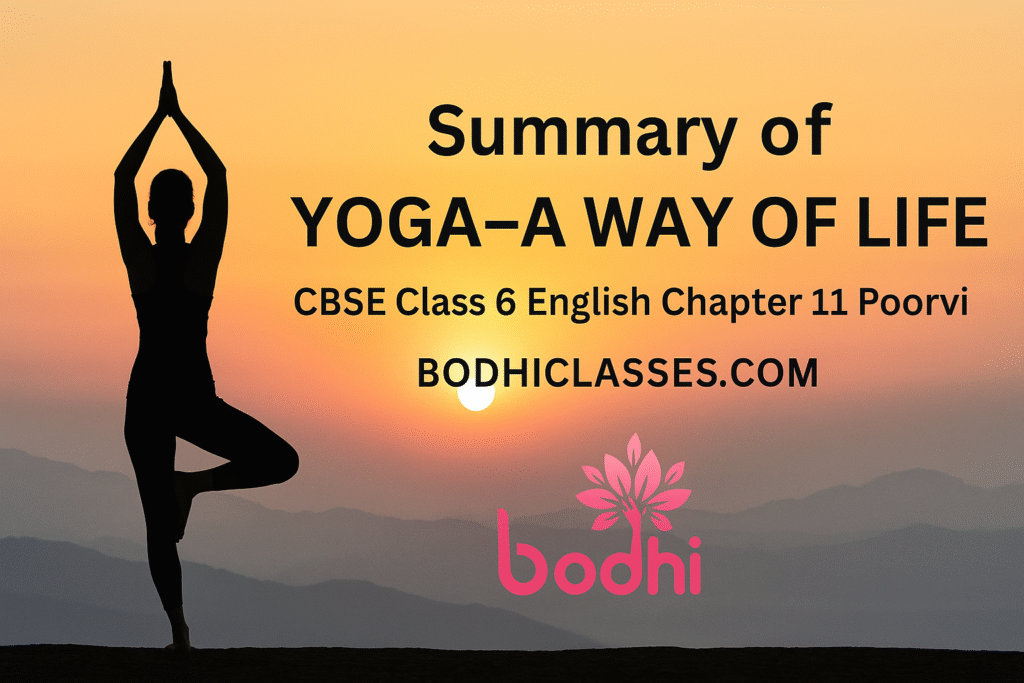Looking for a clear, student-friendly Summary of Yoga-A Way Of Life that will boost your exam prep and web visibility? You’re in the right place! This post delivers a concise yet comprehensive Summary of Yoga-A Way Of Life from CBSE Class 6 English (Poorvi, Chapter 12), spotlighting yoga’s ancient roots, its physical and mental benefits, and the WHO mYoga initiative. By weaving essential keywords, semantic variations, and long-tail phrases naturally into the text, this introduction helps search engines—and curious learners—instantly recognize the value BodhiClasses.com offers. Read on to discover how yoga unites mind, body, and lifestyle while elevating your understanding (and rankings) in one smooth stretch!

Summary of Yoga-A Way Of Life| CBSE Class 6 English Chapter 12 Poorvi

SUMMARY
The chapter “Yoga – A Way of Life” discusses yoga as a holistic physical, mental, and spiritual practice that originated in ancient India. The term “yoga” comes from the Sanskrit root “yuj,” meaning “to unite,” which symbolizes the unity of mind and body. Sage Patanjali systematized yoga through the “Yoga Sutras,” highlighting yoga’s power to calm the mind.
The chapter explains that yoga has gained popularity worldwide because of its health benefits. Yoga helps improve physical fitness by enhancing flexibility, muscle strength, balance, and endurance. It also aids in reducing pain, including lower back pain. The mental benefits include reducing stress, improving sleep quality, and increasing concentration through breathing exercises and meditation. Yoga also supports cardiovascular health, weight loss, and boosts immunity. Recognizing these benefits, the World Health Organization (WHO) launched the WHO mYoga app in 2021 to encourage global yoga practice.
The chapter emphasizes that yoga is a practice that requires full coordination of mind and body, and it should be practiced without distractions. It encourages students to think about the benefits of yoga and to discuss and reflect on how it contributes to overall well-being. It also includes several activities, like writing a paragraph on the benefits of yoga, group discussions, and finding information about specific asanas.
Overall, yoga is described as a way to improve not only physical health but also mental well-being and lifestyle, creating harmony between the body, mind, and nature.
WORD MEANINGS | Summary of Yoga-A Way Of Life
| Word | Meaning |
| Yoga | Physical, mental, and spiritual practice originating from ancient India. The word means “to join” or “to unite.” |
| Harmony | Balance or agreement between different parts. |
| Distractions | Disturbances that prevent focus. |
| Asanas | Physical postures or poses in yoga. |
| Flexibility | The ability to bend or move the body easily without breaking. |
| Endurance | Capacity to continue without giving up; stamina. |
| Meditation | Practice of focusing the mind to achieve mental clarity and relaxation. |
| Anxiety | A feeling of worry or nervousness. |
| Boost | Increase or improve. |
| Circulation | Movement of blood throughout the body. |
| Immune System | The body’s defense system against infections. |
| WHO mYoga | An app launched by WHO to support yoga practice through videos and audio files. |
| Pranayama | Breathing techniques used in yoga to control the breath and focus the mind. |
In essence, the Summary of Yoga-A Way Of Life underscores why yoga is far more than a set of poses—it’s a holistic pathway to harmony, health, and heightened awareness. From Sage Patanjali’s wisdom to modern-day WHO support, the chapter shows that regular practice nurtures flexibility, calm, endurance, and immunity—qualities every Class 6 learner (and busy adult) can embrace. Keep revisiting this summary before exams, share it with classmates, and explore our growing library of CBSE resources on BodhiClasses.com to stay ahead—mindfully and academically.

ALSO READ

